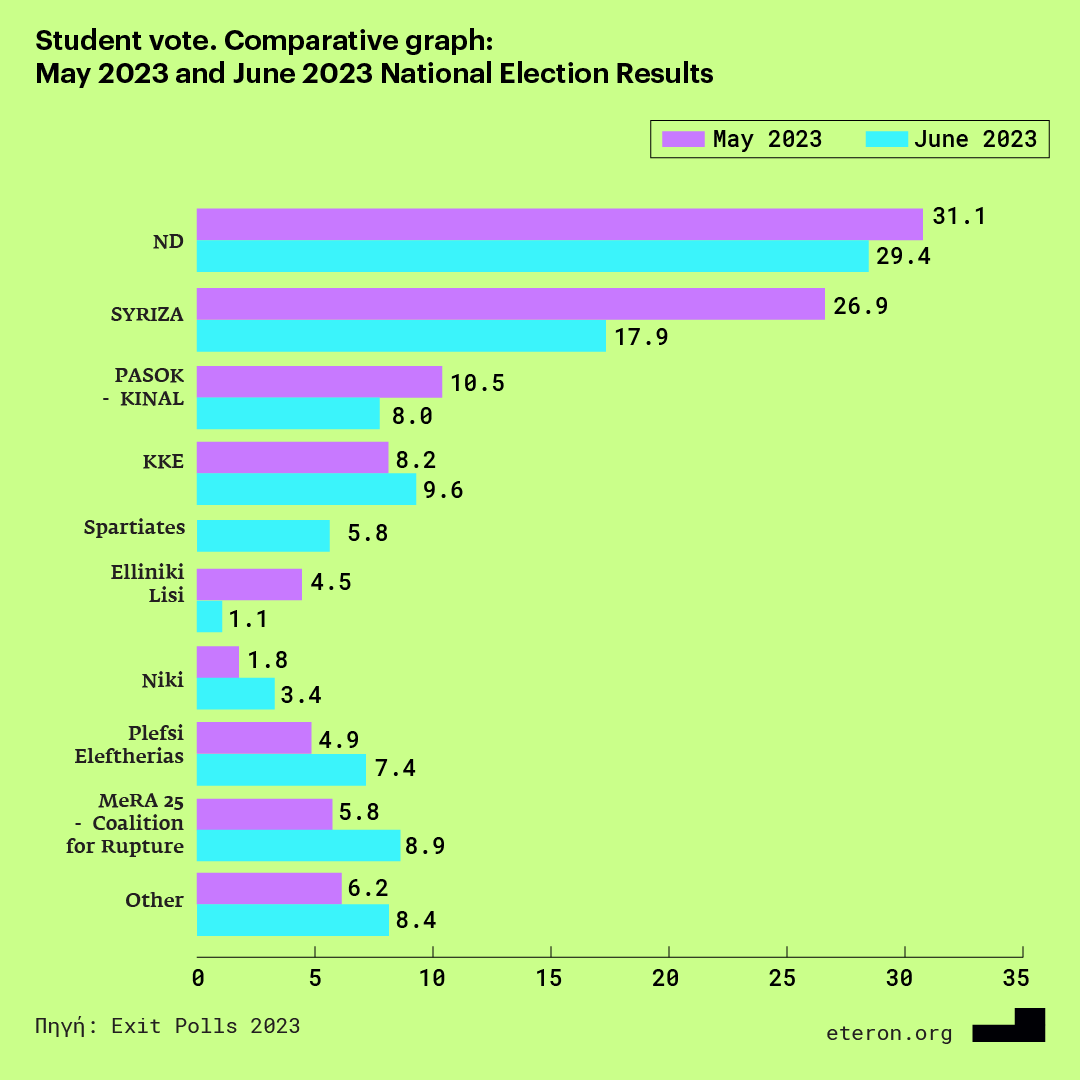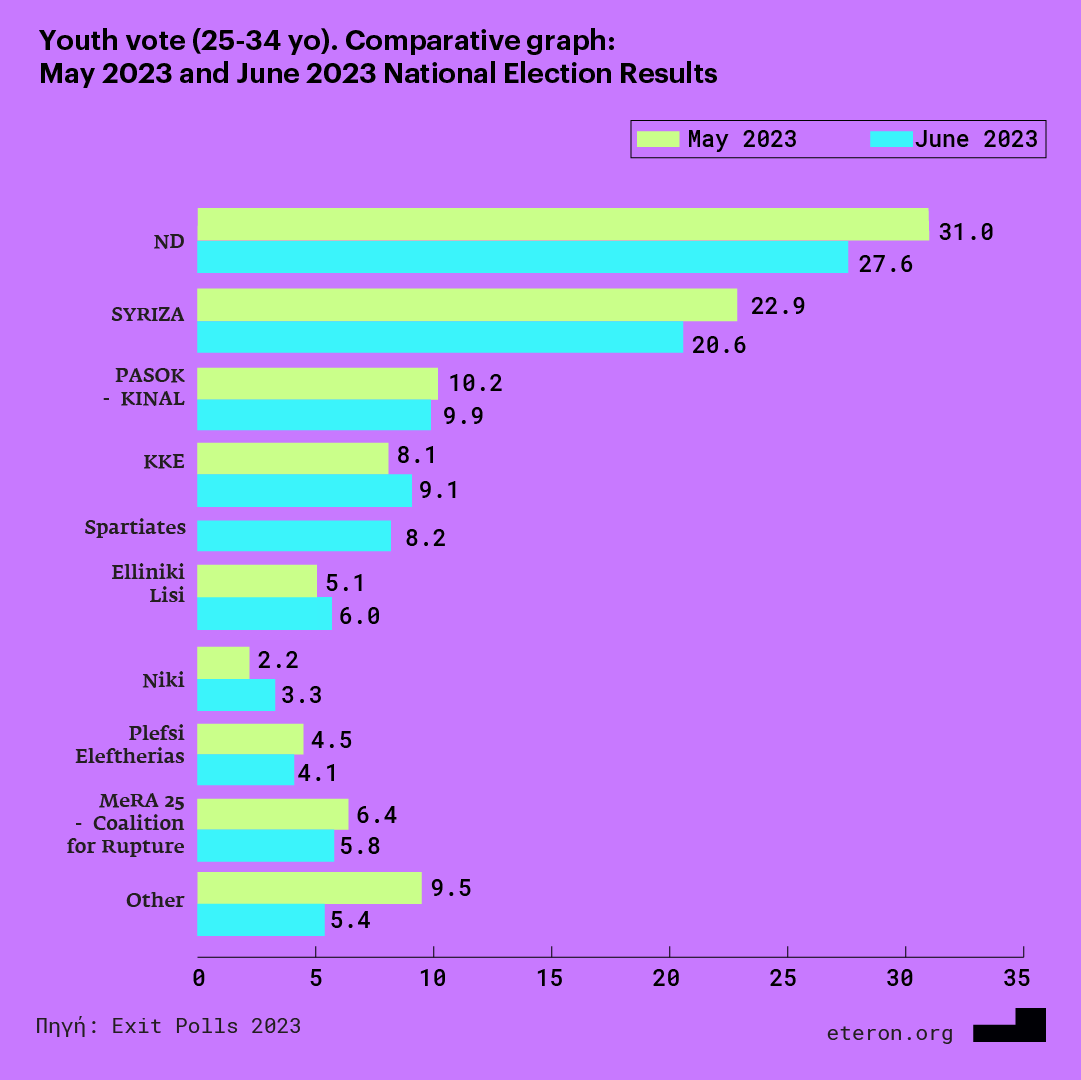
The youth vote: From May 2023 to June
Continuing the dialogue that has started as part of the “Youth – Voice On” project on the subject of the youth vote, today we publish the second part of our comparative overview of the parliamentary election results, focusing on the elections of the 25th of June 2023 and comparing them with how young people voted in the elections of the 21st of May. For both May 21st and June 25th we have drawn our data from the Joint Exit Poll Results Report (Metron Analysis, Alco, Marc, MRB, GPO), available from Metron Analysis.
In the June 25 parliamentary elections, the survey was conducted amongst a representative sample of 5,029 voters, with face-to-face interviews outside 90 polling stations nationwide. As explained in the first part of this feature, where we present comparative graphs for the 2019 and May 2023 parliamentary elections, “exit polling” in practice means setting up “second ballot boxes” outside a representative sample of polling stations, where a number of people who have just casted their votes, are asked to fill in a questionnaire indicating their gender, age, education, etc., as well as the party they have just voted for.
Before turning to the young people’s vote, we should cite the results of the June 25th elections, in order to have a yardstick for comparing the electoral influence of each party on the young generation and, at the same time, the electoral influence at a general population level. More specifically, in the June 25th elections, Nea Dimokratia recorded a 40.56% lead and formed an autonomous government, while the decline of SYRIZA – PS continues, with the opposition party recording 17.83%. PASOK-KIN.AL. is in third place with a marginal increase in its share (11.84%). The KKE also shows a slight increase compared to the May elections with 7.69%.
Moreover, there are several parties to the right of Nea Dimokratia that secured parliamentary representation. Endorsed by Ilias Kasidiaris, who is convicted and sentenced for leading the criminal organisation Golden Dawn, Spartiates ran for elections for the first time and came in fifth place with 4.63%. They are followed by Elliniki Lisi (4.44%) and Niki (3.69%). Finally, with 3.17%, Plefsi Eleftherias ensured parliamentary representation having as their central slogan “Neither Right nor Left. Let’s look ahead”.
MeRA25 – Coalition for Rupture only received 2.5% of the vote and thus didn’t pass the 3% threshold for entering the Parliament, while in total, the parties that didn’t secure parliamentary representation, received 6.15% of the votes.
In this context, below you can find comparative data on the youth vote, as derived from the exit polls in the parliamentary elections of May 21st and June 25th 2023: a. amongst 17-24 year olds (graph 1), b. more specifically amongst students (graph 2) and c. amongst 25-34 year olds (graph 3).

Graph 1
Nea Dimokratia recorded a 28.8% share of the vote among young people aged 17-24, down 4.3 percentage points compared to the May parliamentary elections. In the student vote, Nea Dimokratia’s influence decreases from 31.1% to 29.4%, while in the 25-34 age group it drops by 3.4 points to 27.6%.
Nea Dimokratia recorded a 28.8% share of the vote among young people aged 17-24, down 4.3 percentage points compared to the May parliamentary elections. In the student vote, Nea Dimokratia’s influence decreases from 31.1% to 29.4%, while in the 25-34 age group it drops by 3.4 points to 27.6%.
Overall, the party records a lead in the second election as well. At the same time, the differences in Nea Dimokratia’s electoral influence in each age bracket are impressive. While its electoral influence in the 35-54 age group stands at 39% and in the 55+ age group even reaches 47.1%, we still find it to be less than 30% amongst the younger generation. In any case, it is important to keep an eye on what Nea Dimokratia’s second consecutive leading result will mean in terms of its broader social and political influence on the younger generation.
SYRIZA – PS keeps losing ground in terms of its electoral influence amongst the younger generation. Compared to the May elections, the party registered a 4.9 percentage points drop amongst the 17-24 age group, a 9 points drop in the student vote and a 2.3 drop in the 25-34 age group. Therefore, according to the aforementioned data, it comes in second place, having received very low scores compared to its usual electoral performance amongst young people, with 19.2% (17 – 24 years old), 17.9% (students) and 20.6% (25 – 34 years old).
PASOK – KIN.AL. recorded a marginal increase and received 10% in the 17-24 age group and a slight decrease amongst 25-34 year-olds, with a rate of 9.9%. In both of these age categories, the party comes in third place. On the other hand however, PASOK registered a 2.5 percentage points decrease in the student vote compared to the May elections (8%) and came in fifth place as it was outperformed by both KKE and the MeRA25-Coalition for Rupture.
KKE keeps gaining ground with the younger generation. In the 17-24 age group it reached 8.2% while also increasing its electoral influence by 1 percentage point amongst young people aged 25-34 with a rate of 9.1%. The rise of KKE is also significant amongst students, where from 8.2% in the May elections it is now in third place with 9.6%. It is worth noting that KKE’s student brunch, Panspoudastiki, has been in first place for the past two years in the student elections.

Graph 2
The impact of the far right on the young generation is also worth noting. This phenomenon highlights the need for a deeper understanding of the ways in which the far right reaches the young audiences in order to then be able to address the phenomenon. Endorsed by Ilias Kasidiaris, who was convicted and sentenced as a leader of the criminal organisation Golden Dawn, the far-right party Spartiates ran for the first time and recorded its highest rates among the younger generation. In the 17-24 age group it is at 7.8%, in the student vote at 5.8% and among voters aged 25-34 at 8.2%.
Elliniki Lisi drops from 4.6% to 2.1% amongst voters aged 17-24, from 4.4% to 1.1% in the student vote and increases its rate from 5.1% to 6% amongst voters aged 25-34.
Niki increases its percentage to 2.7% in the 17 – 24 age group (+0.4 percentage points), 3.4% in the student vote (+1.6 pp) and 3.3% in the 25 – 34 age group (+1.1 pp).
Plefsi Eleftherias also continues to increase its influence and records its best results amongst the younger generation. More specifically, it registers 6.8% in the 17 – 24 age group (+ 0.9 percentage points), 7.4% in the student vote (+2.5 pp), while in the 25 – 34 age group it drops from 4.5% to 4.1%.
Finally, MeRA25 – Coalition for Rupture increases its overall share amongst the younger generation, although it will not be represented in parliament due to its very low rates in the older age groups (2.4% in the 35-54 age group and 1.7% in the 55+ age group). More specifically, it gained 6.6% of the 17-24-year-olds’ vote (+1.5 percentage point) , while it dropped from 6.4% to 5.8% in the 25-34 age group. It is worth mentioning its results in the student vote where it came in 4th place with 8.9% (+3.1 pp).

Graph 3
The percentage of young people who voted for parties that we haven’t mentioned in this report is 7.8% in the 17-24 age group, 8.4% among students and 5.4% in the 25-34 age group. However, we do not have data on how the youth vote is distributed among the other non-parliamentary parties.
As it has been correctly pointed out, it is wrong to limit any analysis to just percentages, it is therefore important to take into account the number of votes received by each political party (see detailed data from the Ministry of Interior), the age composition of the electorate (see electorate statistics, Ministry of Interior, p. 33 – in Greek) and of course the elephant in the room, which is none other than the high level of abstention, which reached a record high of 47.17%.
So there are many questions arising after the second ballot. For all these reasons, the dialogue that Eteron has initiated will continue in the coming period in order to record and analyse the new context, focusing on the political stakes of the near future and the correlation of the electoral attitude with the broader profile of young people, their dynamics, transformations and positions on a number of political, value and ideological issues.



